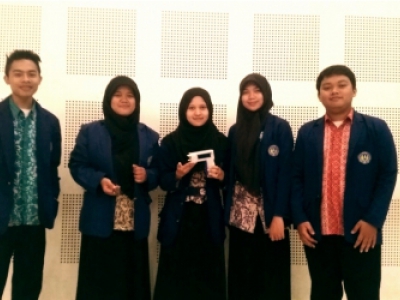ABU DEWA, A COLOR DETECTION TOOL FOR THE VISUALLY IMPAIRED

A group of Yogyakarta State University (YSU) chaired by Ageng Widi Atmoko (Electrical Engineering Education 2014) and consisting of Puput Pujiyanti (Physics Education 2013), Hendriana Helda Pratama (Electrical Engineering Education 2013), Nony Dias Frimana (Out-of-school Education 2013) and Fenti Richa Rukmana (Biology Education 2014) has received grants from the Ministry of Higher Education and Research in the 2016 Student Creativity Program (PKM).
The team proposed a work in PKM KC (Cipta Karsa) entitled ABU DEWA, a Color Detection Tool for the Vision Impaired and the Color Blind. This tool helps detect 15 different kinds of colors consisting of red, pink, dark red, blue, light blue, dark blue, green, light green, brown, orange, purple, grey, yellow, white, and black.
Ageng, the Chairman of the Team explained that ABU DEWA has been through several stages, namely putting the components from microcontroller. "When button 1 is pressed, the microcontroller will retrieve data R, G, B, C (red, green, blue, and clear) that serves as a transmitter and receiver, and then the data will be processed and displayed on the LCD," he explained.
"When we press the Button 2, the data will be sent to the PC and then the next stage is identification of the color. TCS 230 sensor is used to conduct measurements of brightness of colors, and then differentiates the bright objects from the dark objects," he added.
"The color sensor can detect the color of objects made of cloth and paper that is not glossy, and the Buzzer can release a sound which corresponds to the color of objects scanned while the LCD will display the character which corresponds to the color of objects scanned and the push button can work in accordance with the design".
"This color detection will be tested further in the Yaketunis Foundation to find out which parts need to be improved," he said.
Ageng expects that this tool can provide benefits to science as well as experience in creating works. "In addition, it can also provide benefits for the color blind and the visually impaired persons to know the color of an object and make it easy to know the color of an object in daily activities," Ageng added. (haryo)

